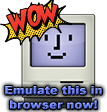Toy trains, model railroads, and computers go back a long way. Many of the early hackers met and worked at MIT's Tech Model Railroad Club. While they made significant advances in computing, they never did get the trains computerized—until very recently. Now Maclnooga Choo-Choo really brings toy trains and computers together. That's because MeacInooga is a true electronic train set.
The program comes with five layouts ready to run. The different layouts illustrate all of the program's features. Some have invisible track, others glory in their MacPaint-created scenery, All are fun to operate. Just beware of crashes, which lead to results unimaginable on the real thing.
The layouts provided are easy to modify using the wide range of tools available. Simple program-generated scenery can be added to MacPaint-created scenery that is already in place. Users can add signals, which will stop trains if they're set to, uncouplers, more locomotives and more cars. Several designs of each type are provided on a handy Train palette.
Once the layout is set, trains are set into motion with the mouse and all speed and directional control is accomplished with the mouse. Be careful when running trains, or you'll crash them! Crashes of electronic trains are rather different from crashes of electric trains (or programs, for that matter). Here crashed trains proceed on their rather merry way. They look and move as though they were drunk!
Empire builders can start from scratch and build up a reasonable layout. Just like real toy trains, the space available is limited, but ample for all but the most land-greedy. As in real life, it is better to lay your track after you do the scenery. Laying multiple tracks is accomplished using the Burrow command which allows the builder to treat each element in the grid square. separately. About all that's missing is the electrical smell of warm motors and transformers and the ability to view your creation from anything other than a bird's-eye view.
Bobker, Steven. (April 1986). MacInooga Choo-Choo. MacUser. (pg. 34).
 Games
Games macinooga_dsk.sit
macinooga_dsk.sit

 Mini vMac
Mini vMac




